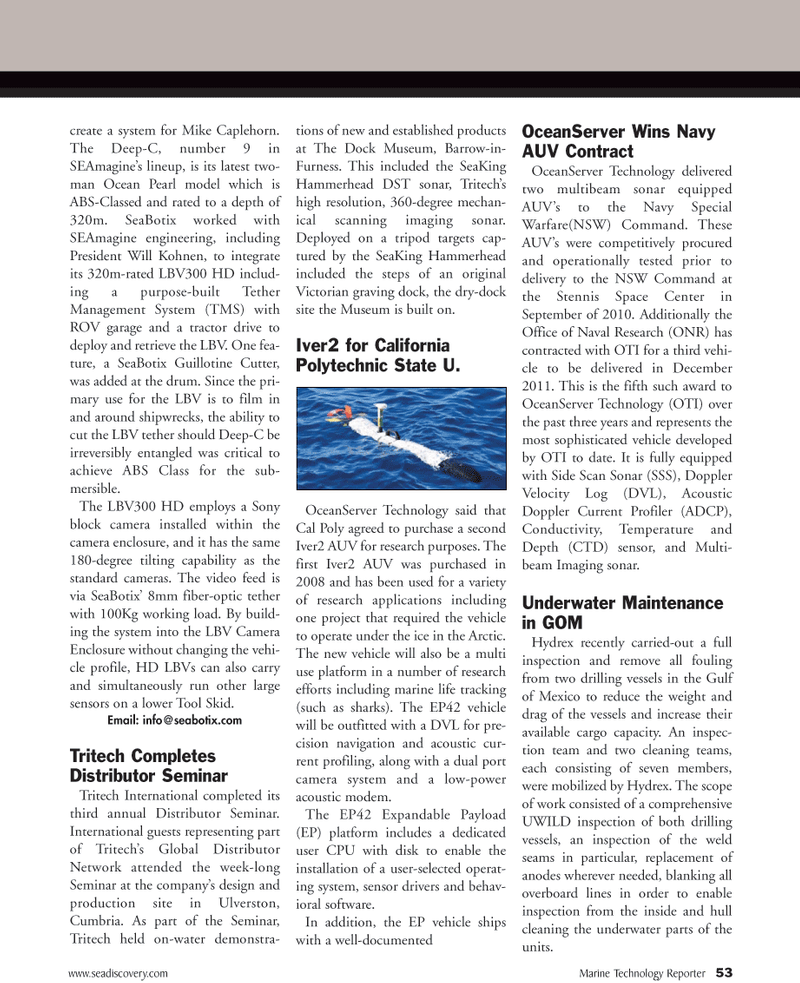
Page 53: of Marine Technology Magazine (November 2010)
Fresh Water Monitoring and Sensors(lakes, rivers, reservoirs)
Read this page in Pdf, Flash or Html5 edition of November 2010 Marine Technology Magazine
www.seadiscovery.com Marine Technology Reporter 53 create a system for Mike Caplehorn.
The Deep-C, number 9 in
SEAmagine’s lineup, is its latest two- man Ocean Pearl model which is
ABS-Classed and rated to a depth of 320m. SeaBotix worked with
SEAmagine engineering, including
President Will Kohnen, to integrate its 320m-rated LBV300 HD includ- ing a purpose-built Tether
Management System (TMS) with
ROV garage and a tractor drive to deploy and retrieve the LBV. One fea- ture, a SeaBotix Guillotine Cutter, was added at the drum. Since the pri- mary use for the LBV is to film in and around shipwrecks, the ability to cut the LBV tether should Deep-C be irreversibly entangled was critical to achieve ABS Class for the sub- mersible.
The LBV300 HD employs a Sony block camera installed within the camera enclosure, and it has the same 180-degree tilting capability as the standard cameras. The video feed is via SeaBotix’ 8mm fiber-optic tether with 100Kg working load. By build- ing the system into the LBV Camera
Enclosure without changing the vehi- cle profile, HD LBVs can also carry and simultaneously run other large sensors on a lower Tool Skid.
Email: info@ seabotix.com
Tritech Completes
Distributor Seminar
Tritech International completed its third annual Distributor Seminar.
International guests representing part of Tritech’s Global Distributor
Network attended the week-long
Seminar at the company’s design and production site in Ulverston,
Cumbria. As part of the Seminar,
Tritech held on-water demonstra- tions of new and established products at The Dock Museum, Barrow-in-
Furness. This included the SeaKing
Hammerhead DST sonar, Tritech’s high resolution, 360-degree mechan- ical scanning imaging sonar.
Deployed on a tripod targets cap- tured by the SeaKing Hammerhead included the steps of an original
Victorian graving dock, the dry-dock site the Museum is built on.
Iver2 for California
Polytechnic State U.
OceanServer Technology said that
Cal Poly agreed to purchase a second
Iver2 AUV for research purposes. The first Iver2 AUV was purchased in 2008 and has been used for a variety of research applications including one project that required the vehicle to operate under the ice in the Arctic.
The new vehicle will also be a multi use platform in a number of research efforts including marine life tracking (such as sharks). The EP42 vehicle will be outfitted with a DVL for pre- cision navigation and acoustic cur- rent profiling, along with a dual port camera system and a low-power acoustic modem.
The EP42 Expandable Payload (EP) platform includes a dedicated user CPU with disk to enable the installation of a user-selected operat- ing system, sensor drivers and behav- ioral software.
In addition, the EP vehicle ships with a well-documented
OceanServer Wins Navy
AUV Contract
OceanServer Technology delivered two multibeam sonar equipped
AUV’s to the Navy Special
Warfare(NSW) Command. These
AUV’s were competitively procured and operationally tested prior to delivery to the NSW Command at the Stennis Space Center in
September of 2010. Additionally the
Office of Naval Research (ONR) has contracted with OTI for a third vehi- cle to be delivered in December 2011. This is the fifth such award to
OceanServer Technology (OTI) over the past three years and represents the most sophisticated vehicle developed by OTI to date. It is fully equipped with Side Scan Sonar (SSS), Doppler
Velocity Log (DVL), Acoustic
Doppler Current Profiler (ADCP),
Conductivity, Temperature and
Depth (CTD) sensor, and Multi- beam Imaging sonar.
Underwater Maintenance in GOM
Hydrex recently carried-out a full inspection and remove all fouling from two drilling vessels in the Gulf of Mexico to reduce the weight and drag of the vessels and increase their available cargo capacity. An inspec- tion team and two cleaning teams, each consisting of seven members, were mobilized by Hydrex. The scope of work consisted of a comprehensive
UWILD inspection of both drilling vessels, an inspection of the weld seams in particular, replacement of anodes wherever needed, blanking all overboard lines in order to enable inspection from the inside and hull cleaning the underwater parts of the units.

 52
52

 54
54
